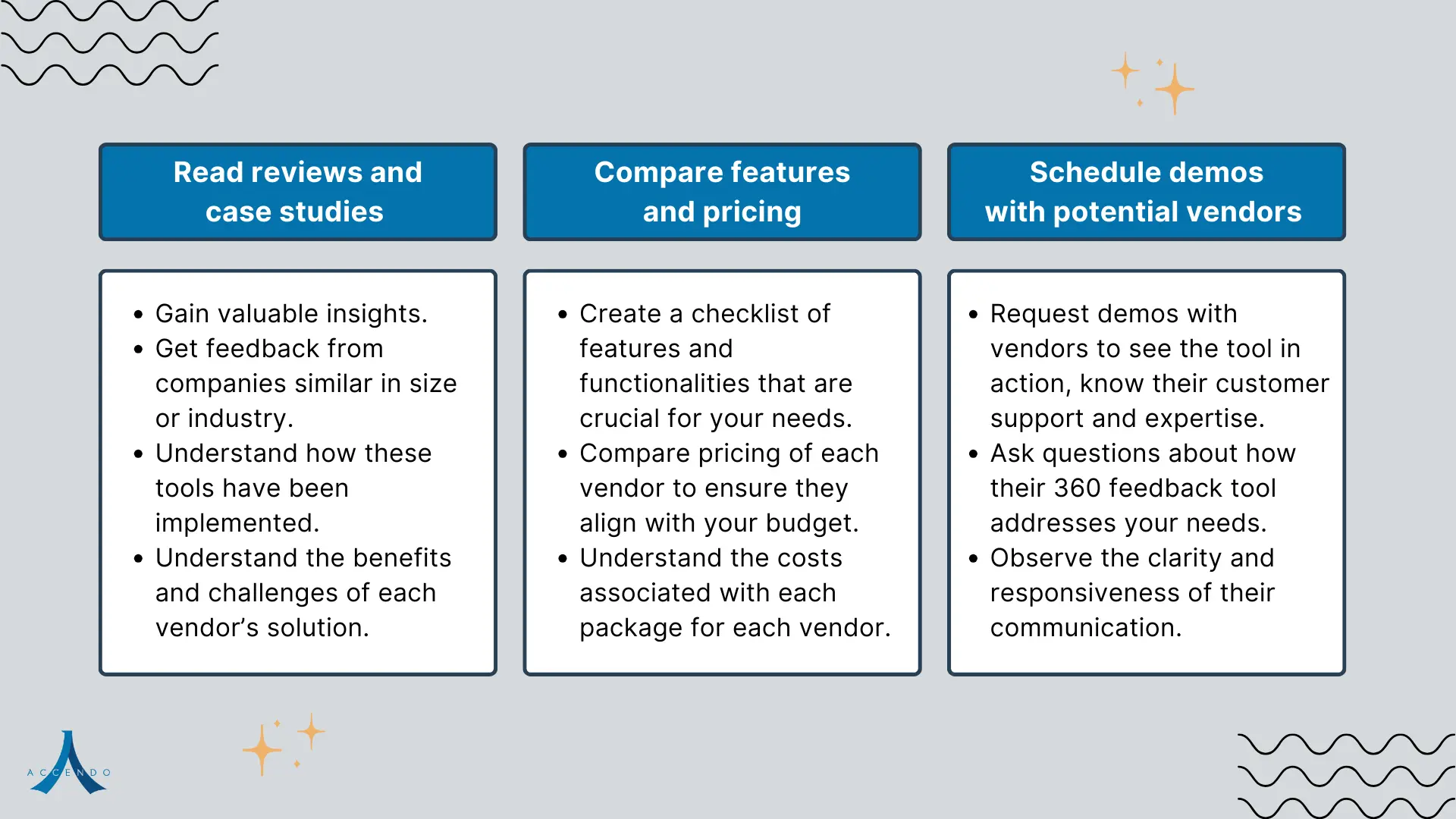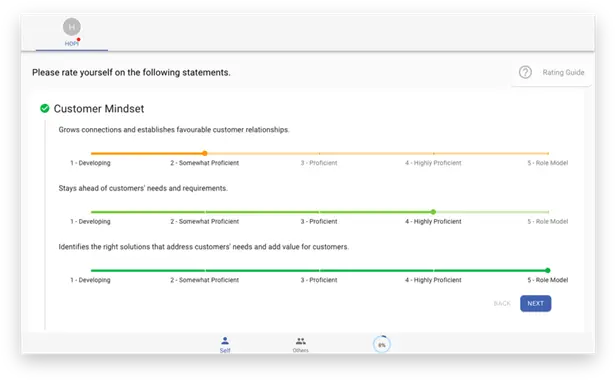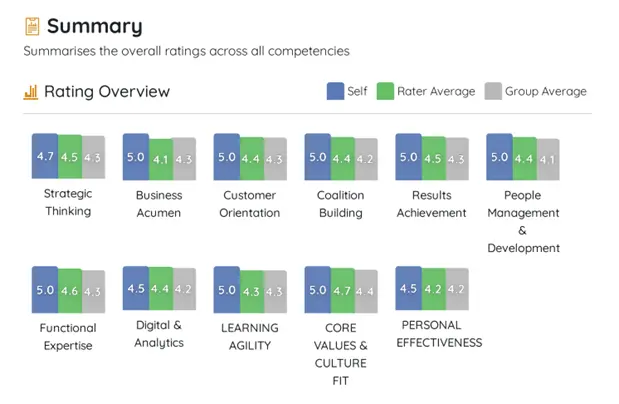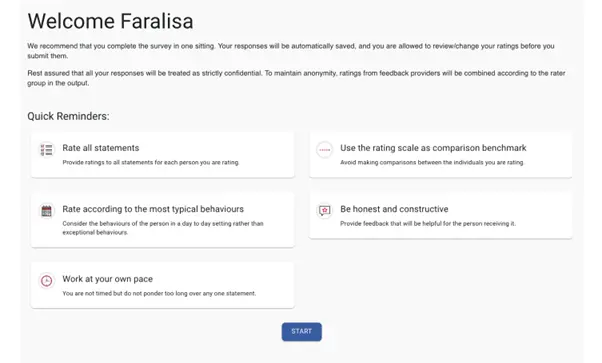
Choosing the right 360 feedback tool vendor is crucial for employee development and success in today’s competitive landscape. But with many vendors offering 360 assessment tools, how do you select the ideal one for your organisation’s strategic goals? Evaluating vendor performance goes beyond just numbers on a contract. Learn why this choice matters, explore the benefits and discover how the best 360 feedback tool can aid your business.
Introduction
Performance feedback is the lifeblood of any organisation. This is often provided during an appraisal, an annual tradition that instils a sense of dread and apprehension even in the most seasoned, battle-hardened executives. So, how can you effectively and holistically evaluate an employee’s performance and offer feedback?
92% of high-performing companies in Malaysia and Singapore actively use 360 Degree Feedback to fine-tune their talent development strategies. (Source: Aon)
A 360-degree feedback software can prove to be invaluable. This blog will delve into the fundamentals of what 360-degree feedback software entails and how to establish your own 360-employee feedback system using the right tool.
What is a 360 Degree Feedback Software?
A 360-degree feedback tool is an assessment method used in the workplace to gather comprehensive feedback about an employee’s performance. It involves collecting input from various sources, including peers, subordinates, supervisors, managers, and sometimes even external stakeholders such as clients or customers.
The collected data is then compiled and presented to the employee to help them gain insights into their performance and areas where they can make improvements. The goal is to facilitate personal and professional development, enhance communication and teamwork, and contribute to an individual’s overall growth within the organisation.
Why Choosing the Right Vendor for Your 360 Feedback Tool Matters
Selecting the right vendor for the best 360-feedback tool is both a procurement and a strategic decision – one that can significantly impact the success of your 360-employee feedback system. According to the Theory of Goal Setting and Task Performance by Locke and Latham, the introduction of a formal feedback system into a group can be highly motivating for employees.
72% of organisations in Malaysia and Singapore report improved leadership development outcomes through the consistent use of 360 Degree Feedback Tools.
Mercer
And making the right choice in today’s business landscape is more crucial than ever. The right vendor should offer:
- Tailored solutions – Customised 360 degree feedback software that align with your company’s unique needs to ensures that the evaluation process is relevant to your specific industry, culture, and objectives.
- Robust data security – Having this in place helps to protect the sensitive feedback provided by employees. This ensures compliance with data protection regulations while instilling trust in your workforce.
- Intuitive and user-friendly interface – This streamlines the feedback collection process, making it easy for participants to provide their input, and for admins to manage and interpret the data.
- Validity and reliability – The best 360 degree assessment tool should come with proven validity and reliability, ensuring that the feedback accurately reflects an employee’s performance.
- Support and training – Resources and assistance should be provided to train administrators, raters, and employees on how to use the 360 employee feedback system effectively.
- Scalability – As your business grows, your feedback needs may change. The 360 employee feedback system should be scalable and adapt to your evolving requirements, whether you have a small team or a large enterprise.
- Feedback analysis – This enables you to derive actionable insights from the feedback data. This is crucial for identifying trends, strengths, and areas for improvement.
The Benefits of Using a 360 Degree Feedback Software
A 360 assessment tool helps to build a skilled, dynamic, engaged, and productive workforce. Due to its many advantages, most of the Fortune 500 organisations are using it for workforce development. The following section talks about the benefits of 360 feedback for contributors, teams, and managers.
Companies using 360 Degree Feedback Tools have experienced a 30% reduction in turnover rates in the Malaysia and Singapore markets.
People Matters Asia
For individual contributors
360 reviews serve as a valuable tool for the growth and development of individual contributors with benefits such as:
- Balanced feedback – 360 reviews offer a well-rounded perspective and constructive insights into an individual’s performance. With input from multiple sources, they provide a broader view of strengths and areas for improvement, reducing the potential for bias.
- Improves communication and relationships – 360 reviews foster stronger bonds among colleagues. Positive feedback creates camaraderie, while constructive input motivates individuals to become better team members. The knowledge received in return can inspire employees to produce their best work and be mindful of their interactions.
- Learning and development – Employees may receive feedback on specific areas, such as improving presentation skills. Meanwhile, managers can guide employees on how to act on this feedback, whether through coaching or relevant training.
- Enhanced self-awareness – Employees can gain insights into their own behaviours, skills, and competencies. This serves as a foundation for personal and professional development.
- Identifying blind spots – The best 360 feedback tool can reveal areas employees may not be aware of. They may need to make improvements, contributing to effective self-development.
For managers
Managers, too, reap substantial benefits from these 360 assessment tools. They receive feedback not only from their direct reports but also from close colleagues, offering several advantages:
- Improved relationships – A staggering 70% of employee engagement variance is attributable to managers. Acting on feedback from direct reports allows managers to enhance relationships, foster leadership traits, and prevent resentment, poor performance, and low morale in their teams.
- Transparency – Managers need to understand how they are perceived by their employees, but obtaining honest feedback can be challenging, especially in hierarchical structures. 360 reviews provide a structured platform for candid conversations, promoting transparency in feedback and benefiting both managers and employees.
- Enhanced team performance – A survey found that only 28% of employees believed their managers were skilled at nurturing engaged teams. However, the 360 performance appraisal tool allows managers to identify areas for improvement and take action. This leads to better-managed teams, inspiring higher performance levels among team members.
- Data-driven decision-making – Organisations can use the collected data to make informed decisions about promotions, training, and development opportunities.
- Tailored development – Feedback gathered can be used to create personalised development plans and help employees focus on areas that require attention and growth.
82% of employees in Malaysia and Singapore prefer companies that provide regular feedback and performance evaluations using tools like 360 Degree Feedback.
JobStreet Insights
Factors to Consider When Choosing a 360 Feedback Tool Vendor
The success of your 360 performance appraisal tool hinges on making a well-informed choice regarding the best 360-feedback tool vendor. There are several key factors that warrant careful consideration, including:

Features and functionality
The key features that you should look for are customisable assessments, scalability, reporting and dashboards, integration, and mobile compatibility. The 360 assessment tool should also align with your organisational goals and requirements, providing the depth of analysis and reporting to empower meaningful performance improvements.
Usability
A user-friendly interface ensures that the best 360-feedback tool can be efficiently utilised by both participants and administrators. This includes clear navigation, a consistent layout, responsive design, and logical flow. The 360 performance appraisal tool should streamline the feedback process, making it an intuitive experience for all involved.
Customer support
Assess the level of customer support provided by the vendor. Look for a partner who offers comprehensive support, including training, to help your team make the most out of the 360 assessment tool. Access to assistance in case of technical issues or queries is invaluable.
Pricing
A significant consideration is the pricing structure. Evaluate the cost associated with the 360 employee feedback system and whether it aligns with your budget. Ensure that you understand all associated costs, including any hidden fees, prior to making an informed decision.
77% of companies in Malaysia and Singapore believe that regular feedback through 360 Degree Assessments leads to higher productivity.
HRM Asia
Reputation
Investigate the vendor’s reputation in the industry. Read reviews, case studies, and references from other organisations to gain valuable insights into their track record of delivering effective 360-degree feedback software and support.

How to Evaluate Different 360 Feedback Tool Vendors
When considering how to evaluate different 360-degree assessment tool vendors, it is essential to take a methodical approach to make an informed decision. Here are some key steps to guide your evaluation process.

Read reviews and explore case studies
Before selecting a 360 feedback tool:
- Conduct comprehensive research by examining reviews from various vendors. These reviews offer valuable insights into the experiences of organisations similar in size or industry.
- Study real-world implementations of these tools helps you gain practical knowledge of the benefits and challenges associated with each vendor’s solution.
Compare features and pricing
To simplify vendor selection:
- Compile a checklist for essential features like customisable feedback surveys, data security, reporting, and integration capabilities tailored to your company’s requirements.
- Do a comparison of vendors’ pricing structures to ensure alignment with your budget
- Understanding the costs associated with tiered pricing or customised packages is essential for informed decision-making.
Schedule demos and calls with potential vendors
When deciding on a vendor:
- Reach out to your preferred choices to schedule demos or calls to evaluate their customer support, expertise, and the software’s alignment with your organisational needs.
- Request live software demos and pay attention to their communication responsiveness and clarity to gain insights into the level of support you might receive as a customer.
SEA’s Top Tool to Drive Performance: Accendo’s 360 Degree Feedback Tool
Accendo’s 360-Five Multi-Rater tool serves as a comprehensive feedback solution that is available in our marketplace. The Accendo 360 feedback tool is on our Assessment Marketplace, utilised by organisations to enhance talent management, meet talent needs, and gain insights from various sources to drive informed decision-making.
Organisations that utilise 360 Degree Feedback Tools see a 27% increase in employee engagement in the Malaysia and Singapore regions.
People Management Asia
The Accendo 360 feedback tool gathers input on employees’ job performance from various sources, including colleagues, subordinates, superiors, customers, and stakeholders. Surveys, offer a comprehensive view of an employee’s strengths and weaknesses, aiding in goal setting, professional development planning, and performance discussions.

At the same time, the Accendo 360 feedback tool empowers HR teams and managers to make informed decisions and boost the overall effectiveness of talent management by gathering qualitative and quantitative feedback from diverse sources.
Key features
The Accendo 360 feedback tool comes with the following features:
- Mobile compatibility allows on-demand feedback to be captured anytime, anywhere.
- Pre-built question bank that can be contextualised to an organisation’s competency framework.
- A seamless user experience enables the provision of feedback with ease and obtain instant insights.
- Integrated administration with Accendo’s TalentPulse to combine with other data for consolidated output.
- Holistic evaluation across various competencies and skills which are both qualitative and quantitative.
- Support for multiple rater groups and real-time feedback in different rating formats.

On TalentPulse, the 360-Five Multi-Rater consolidated report showcases an individual’s workplace behaviours across a range of competencies and skills. The Accendo 360 feedback tool report highlights their strengths and development areas based on the feedback provided, which can be used for performance and development conversations, including:
- Key highlights for targeted focus, such as highest and lowest rated competencies, oversight, hidden potential, and competencies.
- A comparison between self-rating, ratings from others, and group average for each competency and their individual items.
- Competency items are ranked from highest to lowest based on average ratings from others and compared to self-ratings to find areas of difference for further examination.
Why choose Accendo’s 360-Five Multi-Rater Tool over other vendors
The primary goal of the Accendo 360 feedback tool is to make feedback inclusive and accessible for organisations. Gathering constructive feedback from a multitude of sources is crucial for leaders seeking to explore career development opportunities and propel their businesses forward. Need help? Here are three reasons why companies choose the Accendo 360 feedback tool over other vendors:
A scalable tool that gives in-depth insights into your employees
- The Accendo 360 feedback tool offers in-depth insights into your employees, driving development, productivity, and engagement.
- Managers gain the capability to engage in more actionable conversations, leveraging trends and analysis derived from the 360 feedback data.
A powerful dashboard for real-time monitoring and group trends
- For managers, the ability to make swift talent decisions is facilitated through user-friendly yet impactful dashboards that display feedback data.
- The Accendo 360 feedback tool empowers leaders to initiate change, track progress, and channel their efforts towards enhancing employee performance.
Actionable development reports for employee career progression
- Reports from the Accendo 360 feedback tool serve as visual representations of feedback and as conversation starters.
- Data gathered from the entire employee journey on one platform helps you see how your employee development efforts impact the business.
Insights for Choosing the Best 360 Feedback Tool for Your Business
Selecting the best 360 feedback tool for your business demands a thoughtful assessment of your unique needs and requirements. The best 360 feedback tool should align seamlessly with your organisation’s goals and culture. To start, consider the following key factors:
Consider your specific needs and requirements
Selecting the ideal 360 feedback tool for your business hinges on a thorough assessment of your unique needs and goals.
- Tailoring your choice to your organisation’s specific objectives is crucial.
- Aligning your goals with the appropriate 360-degree feedback software to access the insights necessary to achieve your desired outcomes.
89% of companies in Malaysia and Singapore report improved employee performance after implementing 360 Degree Feedback Tools.
HR Insights Asia
Setting a budget
In the decision-making process, budget considerations are pivotal.
- Assess the financial resources allocated for implementing the optimal 360-degree feedback software, striking a balance between your budget and the tool’s quality.
- Investing in a dependable 360-degree assessment tool can yield significant returns in employee development and organisational progress.
Getting buy-in from stakeholders
Secure buy-in from your stakeholders such as top management, HR teams, and department heads.
- Highlight the tool’s value and benefits while addressing their concerns and outlining its alignment with the company’s strategic goals.
- Early engagement with stakeholders cultivates ownership and commitment to the process, streamlining its integration for maximum effectiveness.
Key Actionable
Accendo’s 360-Five Multi-Rater tool is a dynamic and comprehensive 360 degree feedback tool that can help you improve employee performance and engagement. It provides valuable insights into employee strengths and weaknesses, from the perspectives of their managers, peers, and direct reports.
- Provides a holistic view of employee performance – The 360-degree feedback gathered provides a more holistic view of employee performance than traditional performance appraisals, which typically only rely on feedback from managers.
- Helps you set targeted development goals – The 360-degree feedback reports generated by the tool can be used to set targeted development goals for employees. This is because the reports identify specific areas of improvement for each employee. By setting targeted development goals, you can help employees improve their performance and develop their skills.
- Promotes a culture of feedback and continuous learning – The 360-degree feedback process helps to create a culture of feedback and continuous learning within your organisation. This is because it encourages employees to give and receive feedback from each other on a regular basis. This can lead to improved communication, trust, and collaboration between employees, which can all contribute to organisational growth.
Unlock the full potential of the 360-Five Multi-Rater tool with a FREE trial from Accendo. Leverage valuable insights to elevate employee performance and foster professional growth effectively.

Frequently Asked Questions (FAQs)
360 feedback assessments should be used when you want to gather comprehensive insights into an individual’s performance, particularly in areas like leadership, teamwork, and personal development. It is commonly used during performance reviews, leadership development programs, or when addressing specific skill development needs.
The four sources for a 360 degree assessments typically include self-assessment, peer assessment, supervisor assessment, and subordinate assessment. This well-rounded approach ensures feedback comes from various perspectives, providing a holistic view of an individual’s strengths and areas for improvement.
360 feedback, or 360 assessments, gather feedback from various sources, including peers, supervisors, subordinates, and self-assessment. In contrast, 180-degree feedback, like a performance review, involves feedback from just one group of sources, such as supervisors or peers.
The benefits of 360 feedback assessments include enhancing self-awareness, pinpointing strengths and weaknesses, improving communication and teamwork, fostering personal and professional development, and aligning individual goals with organisational objectives.
Page Contents







